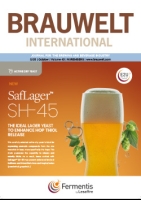Flash Pasteurization of Beer – a Critical Review
The pasteurization of beer and in particular the flash pasteurization is a widely used technique for the biological product stabilization. In spite of the large extend of experience with the pasteurization the way how it is used in practice is a comparably rough method of low precision. In order to precisely adjust the two core process parameters temperature and exposition time detailed knowledge about the individual microbiological inactivation kinetics as well as about specific process and equipment characteristics is required. The article first considers the questions of the biologically demanded thermal load in terms of “required Pasteurization Units (PU)”. The assumed underlying thermal death kinetics and the determination of the necessary logarithmic cell count reduction are discussed. Every claim demanding for a particular target PU for specific kinds of beers (or other beverages) base naturally upon simplifications and assumptions concerning the initial and target cell counts and the D-values of present microorganism. The necessity of both species/strain and matrix specific D-values are pointed out.
In the second step the recalculation of the actually applied thermal load in terms of “effective PU” is critically reviewed. The origin of the questionable so called beer formula is revealed indicating the evident deviations to realistic calculations. In contrast to the assumption in the beer formula the z-value, describing the heat dependency of the D-value, is constant 7°C, it varies in a wide range with species and matrix. This leads to miscalculation of the “effective PU”. Furthermore the both parameters of the pasteurization process time and temperature are commonly simplified to average sizes. Investigations on residence time distributions (RTD) are evaluated and combined with thermal death kinetics of microorganism in order to show the relevance of RTD for the effectively applied thermal load and the “effective PU” respectively. Since the common way to determine the actual thermal effect (effective PU) are microbiological count reduction tests with a comparably low accuracy alternative approaches for an correct determination of the inactivation effect are proposed.
BrewingScience - Monatsschrift für Brauwissenschaft, 64 (March/April 2011), pp. 32-40
Source
BrewingScience – Monatsschrift für Brauwissenschaft
Downloads
- Flash Pasteurization of Beer – a Critical Review (Abstracts_BrewingScience)



